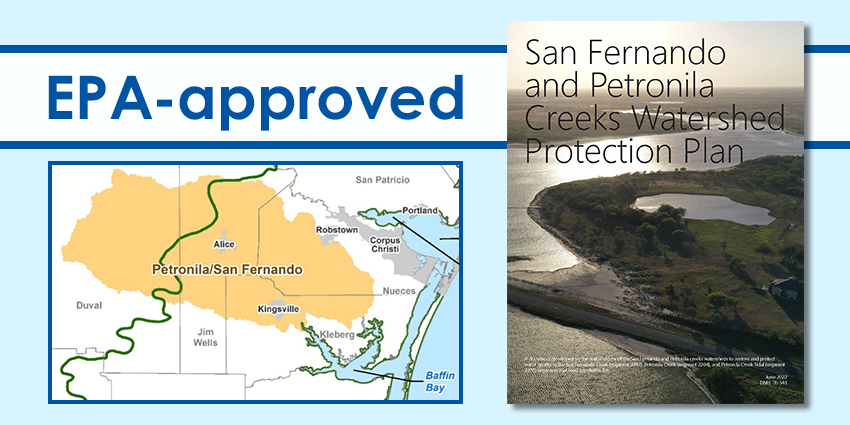The San Fernando and Petronila Creeks Watershed Protection Plan (WPP) has been reviewed and accepted by the U.S. Environmental Protection Agency (EPA), a major accomplishment for the coalition of local stakeholders and state officials who collaboratively created the science-based plan.
Plan acceptance is dependent on meeting EPA’s guidelines for watershed-based plans. The WPP outlines a strategy to implement management measures that will reduce nonpoint source pollution into the creeks and ultimately Baffin Bay.
The plan is available for download at baffin.twri.tamu.edu.
“This plan is the culmination of efforts that started through a grassroots initiative to understand what was happening water quality-wise in Baffin Bay,” said Lucas Gregory, Ph.D., Texas Water Resources Institute (TWRI) associate director and TWRI project manager for the effort. “This plan is the thoughts and ideas of many local stakeholders on what can feasibly be done to improve water quality and protect the wonderful land and water resources in the Baffin Bay watershed.”
Helping Baffin Bay thrive
Baffin Bay is considered a jewel of the Texas coast, supporting some of the state's highest commercial and recreational fishery landings and providing critical habitat for numerous bird and wildlife species. San Fernando and Petronila creeks are two of the three major tributaries to Baffin Bay. Combined, these watersheds cover roughly 1,945 square miles (about half the area of Connecticut) of largely rural land.
San Fernando and Petronila creeks have been considered impaired since 2006 and 2010, respectively, for not meeting the state’s water quality standards for contact recreation due to elevated levels of bacteria, as well as concerns for elevated nitrates, chlorophyll-a and total phosphorus. A large number of fish died during several events which increased local community awareness about the importance of water quality and its impact on Baffin Bay and the surrounding ecosystem.
The Texas State Soil and Water Conservation Board (TSSWCB), in partnership with TWRI, Nueces River Authority, the Harte Research Institute for Gulf of Mexico Studies at Texas A&M University-Corpus Christi, Texas Sea Grant, and the Coastal Bend Bays and Estuaries Program worked to engage local stakeholders and lead them in the process to develop the WPP.
Stakeholders’ input is invaluable
Local stakeholders were engaged through informational meetings, educational programs, and focused discussions regarding the current state of water quality, their concerns for future water resource issues, and what could be done to mitigate these issues.
“This WPP is a direct reflection of the input and dedication provided by local residents and stakeholders,” said Jana Lloyd, the Texas State Soil and Water Conservation Board project manager. "Their time and effort are greatly appreciated and do not go unnoticed.”
During the development of the WPP, general education and outreach were conducted throughout the watershed area. Presentations by project team members were made at numerous events including the Baffin Bay Symposium, the Baffin Bay Stakeholder Group, a local Coastal Conservation Association banquet, local county commissioner’s court meetings, and at local soil and water conservation district meetings. Education programs such as the Texas Riparian and Stream Ecosystem Education, Texas Watershed Stewards, and the Urban Riparian and Stream Restoration were offered through partnerships with the TWRI, Texas A&M AgriLife Extension Service, Texas A&M AgriLife Research and TSSWCB.
“With acceptance of the plan, management measures identified in the WPP are now eligible for funding,” Lloyd said.
This effort was funded through a State Nonpoint Source grant from the Texas State Soil and Water Conservation Board.
More information on the San Fernando and Petronila Creeks Watershed Protection Plan is available at baffin.twri.tamu.edu.


